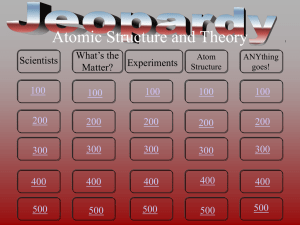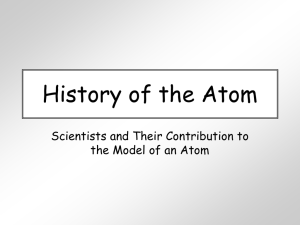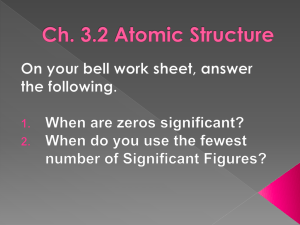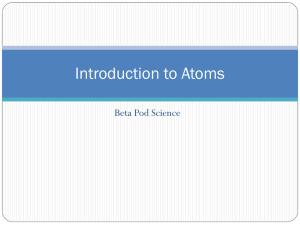20140924153581
advertisement
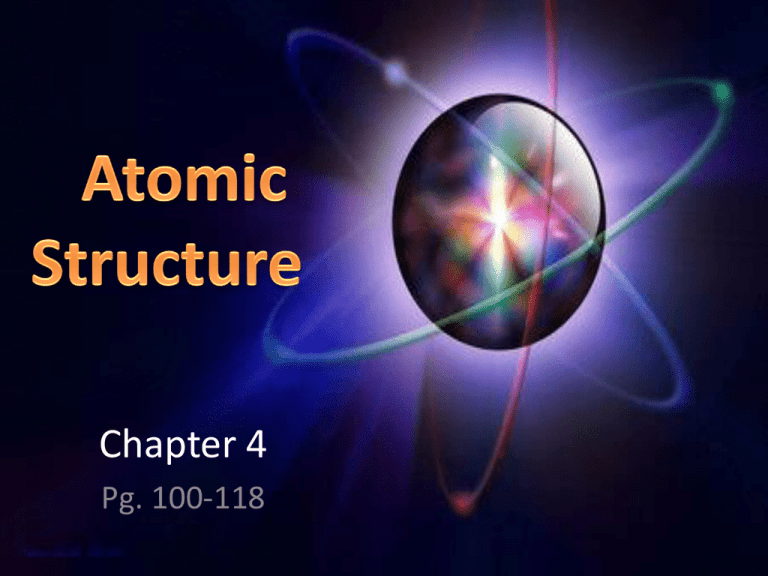
Chapter 4 Pg. 100-118 Ancient Greek Models of Atoms • __________– thought that all substances were built up from only ____ elements: earth, air, fire, and water – matter could be divided an unlimited number of times • __________– believed that all matter consisted of extremely _____ particles that could not be divided – called particles atoms from the Greek word ________, which means “uncut” or “indivisible” Dalton’s Atomic Theory • ____________- born in England in 1766 – Teacher – Interest in predicting the _______, led to his study of the behavior of gases in air -- Correctly concluded that a gas consists of _________ _________ Dalton’s Atomic Theory • Evidence for Atoms – Measured the ______ of elements that combine when compounds form. – Noticed that no matter how _______ or _____the sample, the ratio of the masses of the elements in the compound is always the same (aka fixed composition) Dalton’s Atomic Theory • ________ Theory- Dalton proposed the theory that all matter is made up of individual particles called ______, which cannot be divided. • Main Points of Theory 1. All elements are composed of ______. 2. All atoms of the same element have the same mass, and atoms of ________ elements have different masses. Dalton’s Atomic Theory • Main Points of Theory continued… 3. __________ contain atoms of more than one element. 4. In a particular compound, atoms of different elements always combine in the _____ _____ • Not all of Dalton’s ideas about atoms were completely ______, but scientists did not discard his theory, they revised it to take into account new discoveries Dalton’s Atomic Theory Thomson’s Model of the Atom • When rubbed, some materials gain the ability to ______ or _____other materials. • Based on their ________, they are said to have either positive or negative electric charges. • Objects with ___ charges repel or push apart. Thomson’s Model of the Atom • Objects with ________ charges attract, or pull together. • Some charged particles can flow from one location to another. A flow of charged particles is called an ________ _______ Thomson’s Model of the Atom • J.J Thomson used _______ current to learn more about atoms Thomson’s Model of the Atom • Thomson’s Experiment (pg. 102) – __________ that the beam was a stream of charged particles that interacted with the air in the tube and cause the air to glow. – Placed charged _____ plates at either end-> caused beam to deflect or bend – Observed beam: ________ by negatively charged plate and attracted by positively charged plate Thomson’s Model of the Atom • Evidence for Subatomic Particles – Concluded that the particles in the beam had a _________ charge because they were attracted to the positive plate. – Thomson’s experiments provided the _____ evidence that atoms are made of even ______ particles. – Revised Dalton’s model to account for the ________ particles Thomson’s Model of the Atom • Thomson’s Model – Atom is ______: meaning it has neither a negative nor a positive charge – Negative charges were evenly ________ throughout an atom filled with a positively charged mass of matter – “______ _______” model (may want to think of chocolate chip ice cream) Thomson’s Plum Pudding Model Rutherford’s Atomic Theory • _____, Rutherford discovered that uranium emits fastmoving particles that have a positive charge called _____ ________ Rutherford’s Atomic Theory • Hypothesis: (asked student- _______, to find out what happens to alpha particles when they pass through a thin sheet of gold) Predicted that most particles would travel in a _______ path from their source to a screen that lit up when struck. Rutherford’s Atomic Theory • The _______ ______ Experiment – Aimed narrow beam of alpha particles at gold, the material around the ______ produced a flash of light when struck by fast-moving alpha particles – Could figure out ____ of alpha particles by observing the flash after they had passed through the gold – Did _____ support Rutherford’s prediction Rutherford’s Atomic Theory • Gold Foil Experiment continued… – More particles were deflected than he expected – About 1 out of every ______ was deflected by more than 90 degrees – Some alpha particles behaved as though they had struck an object and bounced _______ back Gold Foil Experiment Rutherford’s Atomic Theory • Discovery of the Nucleus – Alpha particles whose paths were ________ must have come close to another charged object – The closer they came, the greater the deflection – _________: the positive charge of an atom is not evenly spread throughout the atom, it is concentrated in a very small central area- ______ – Nucleus: a dense, positively charged mass located in the center of the atom Rutherford’s Atomic Theory • According to Rutherford’s model, all of an atom’s _______ charge is concentrated in its nucleus Chapter 4 Section 2 Pg. 108-112 Properties of Subatomic Particles • Protons, electrons, and neutrons are _________ particles • Protons: – A __________charged subatomic particle that is found in the nucleus of an atom – Positive charge (amount varies among elements), each proton is _____ – Each _________ must contain at least one particle with a positive charge Properties of Subatomic Particles • Electrons – Comes from Greek word meaning “______” – A _________ charged subatomic particle that is found in the space outside the nucleus – Each electron has a charge ____ Properties of Subatomic Particles • Neutrons – 1932, English physicist J. _________ designed an experiment to show that neutrons exist; concluded particles were ________ because a charged object did not deflect their path – A neutral subatomic particle that is found in the nucleus of an atom – ______ is almost exactly equal to that of a proton Comparing Subatomic Particles • Protons, electrons, and neutrons can be distinguished by _____, charge, and location in an atom. • Protons and neutrons have almost the _____ mass • It would take about 2,000 electrons to equal the mass of one proton • Protons and neutrons are _______ nucleus, electrons are in outside space Atomic Number and Mass Number • ______ predicted that the atoms of any element are different from the atoms of all other elements • Atomic Number – atoms of any given element always have the same number of protons – Atomic number of an _______ equals the number of protons in an atom of that element – _______ of different elements have different numbers of protons Atomic Number and Mass Number • Mass Number – the mass number of an atom is the ____ of the protons and neutrons in the nucleus of that atom. – Ex: an atom of Al with 13 protons and 14 neutrons has a mass number of 27 Atomic mass is the same as mass number Isotopes • Every atom of a given element _____ _____have the same number of neutrons. • Isotopes are atoms of the same element that have different numbers of neutrons and different mass numbers • Isotopes of an element have the ____ atomic number but different mass numbers because they have different number of neutrons M o d e r n A t o m i c Chapter 4 Section 3 Pg. 113-118 T h e o r y Bohr’s Model of the Atom • Bohr was a ______ physicist who worked with Rutherford • Bohr _______ with Rutherford’s model, but Bohr’s model focused on the electrons • Energy Levels – In Bohr’s model, _________ move with constant speed in fixed orbits around the nucleus (like planets around a sun) Bohr’s Model of the Atom • Energy Levels – Each ________ in an atom has a specific amount of energy – If an atom _____ or ______energy, the energy of an electron can change – The possible energies that electrons in an atom can have are called ______ _______ – An electron cannot exist between energy levels Bohr’s Model of the Atom • Energy Levels – An electron in an atom can _____ from one energy level to another when the atom gains or loses energy – The _____ of the jump between energy levels determines the amount of energy gained or lost • Evidence for Energy Levels – Scientists can measure the energy _______ or released when an electron absorbs or releases energy and moves to higher or lower energy levels Bohr’s Model of the Atom Electron Cloud Model • An electron cloud is a ______ model of the most likely locations for electrons in an atom • The cloud is _______ at those locations where the probability of finding an electron is high • Scientists use the electron cloud model to describe the possible _______ of electrons around the nucleus Atomic Orbitals • The ______ _____ represents all the orbitals in an atom • An orbital is a region of space around the nucleus where an ______ is likely to be found • An electron cloud is a good approximation of how electrons behave in their orbitals Atomic Orbitals • Level which an electron has the ____ energy– the lowest energy level– has only one orbital • Higher energy levels have _____ than one orbital • Each orbital can contain _____ electrons at most Electron Configurations • An electron configuration is the __________ of electrons in the orbitals of an atom • The most ______ electron configuration is the one in which the electrons are in orbitals with the _______ possible energies • When all the electrons in an atom have the _______ possible energies, the atom is said to be in its ground state Electron Configurations • If a lithium atom ______ enough energy, one of its electrons can move to an orbital with a higher energy, this ____________ is referred to as an excited state • An excited state is _____ stable than the ground state • Eventually the electron _____ _______and the atom returns to the ground state Electron Configuration • Helium, neon, argon, krypton, and xenon atoms _________ from excited states to the ______ state emit the light you see in “neon” lights

